
which in the recent state were semi-transparent. The peritoneum
and great omentum were similarly diseased.
The woman from whom this specimen was taken, died in
the City of Dublin Hospital, set. forty-five. Her case is recorded
in the second volume of the Dublin Medical Press, p. 69.
She had, for a long time, labored under wandering pains
in different situations, viz. the shoulders, hips, knees, &c.:
together with violent fits of dyspnoea, palpitations the most
exhausting, and extreme debility. The physical signs of solidification
in the lung were noted during life ; but the exact
nature of the disease, though conjectured, was not fully
prognosticated. The symptom which most attracted notice
was, the extraordinary rapidity and regularity of the pulse,
which though it sometimes rose to two hundred and forty
could, nevertheless, be distinctly reckoned.—Prof. Benson.
C. 1. 359. Young llama, acute pleuritis of. The surface
of the pleura, is covered with a thick coating of lymph, which
adheres to it loosely, and presents a spongy, honey-combed
appearance, exactly like that shown in several of the specimens
of human pathology.—Dr. Houston.
C. b. 360. Lynx, pneumonia of. The lung is hepatised,
partly by effused lymph, and partly by red blood. The pleura
is smeared over with lymph.—Idem.
C. b. 361. Mandril, lung of,—solidified to the consistence of
liver, and of a yellowish-white color, except where stained
with extravasated blood.—Idem. .
0. 1. 362. Bear, lung of;—exhibiting an interesting and
perfect specimen of the grey hepatization of Laennec.—Idem.
C. b. 363. Miliary tubercles in the lung of a mandril, accompanied
with pulmonary congestion and pleuritis.—Idem.
0. b. 364. Tubercular infiltration in the lung of a monkey.
Large patches of the white deposits are 'vfrell shown off by an
injection of the sound textures with size and vermilion.—
J. Shekleton, Esf.
0. b. 365. Lungs, heart and liver of a spider-monkey.
The lungs present, in some places, miliary tubercles; in others,
sanguineous hepatization ; and in others, again, their pleural
investments are coated over ^with adherent lymph.—Dr.
Houston.
C. b. 366. Lungs of a striated monkey, exhibiting both
tubercles, and extensive tubercular infiltration, without softening
of the new tissue, in any part.—Idem.
C. b. 367. Lung of a monkey, with a large patch of tubercular
infiltration, in the centre of which is a small abscess.
—Idem.
C. b. 368. Lung of an ape, tuberculated, and so heavy as
to sink in the fluid in which it is preserved. Notwithstanding
the amount of scrofulous deposit, purulent matter has not in
any part been generated.—Idem.
0, b. 369. Lungs of a monkey, the seat.of tubercles and
pleuritis. Similar tuberculous deposits existed in the liver,
(see A. d. 785.) ; the spleen (A. d. 807) ; the kidneys (F. a.
128), &c.—Idem.
0. b. 370. Section of the lung of an axis-deer, loaded
with tubercles—some, consisting of firm tuberculous matter;
others, in a state of central suppuration. Each tubercle
appears, however, to have remained distinct and insulated,
and not to have coalesced with its neighbours, so as to form
larger common cavities, as is usually the case with the same
disease when seated in the human lung; a result which may
probably be owing to the more insulated condition of the
clusters of pulmonary vesicles in the lower mammalia than in
man. A curious illustration tending to prove the accuracy of
this view of the matter may be seen in the lung of a seal,
(see 0. b. 377), affected with chronic hepatization, in which the
clusters maintain perfectly their distinctive characters, in the
midst of such serious disease.—Dr. Houston.
C. b. 371. Fibro-cartilaginous cysts, as large as walnuts